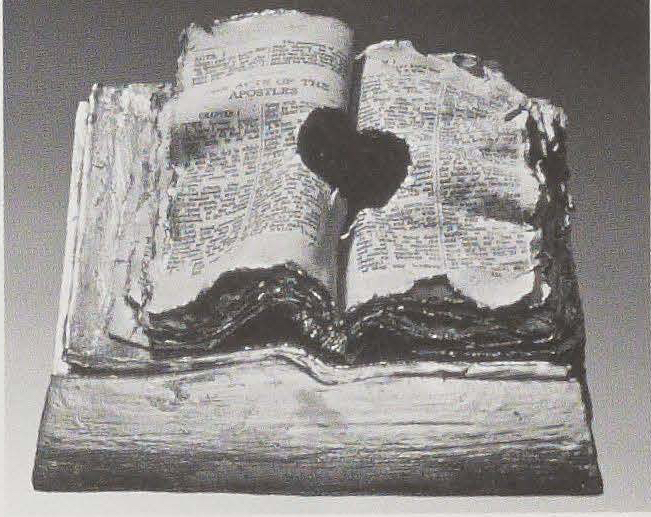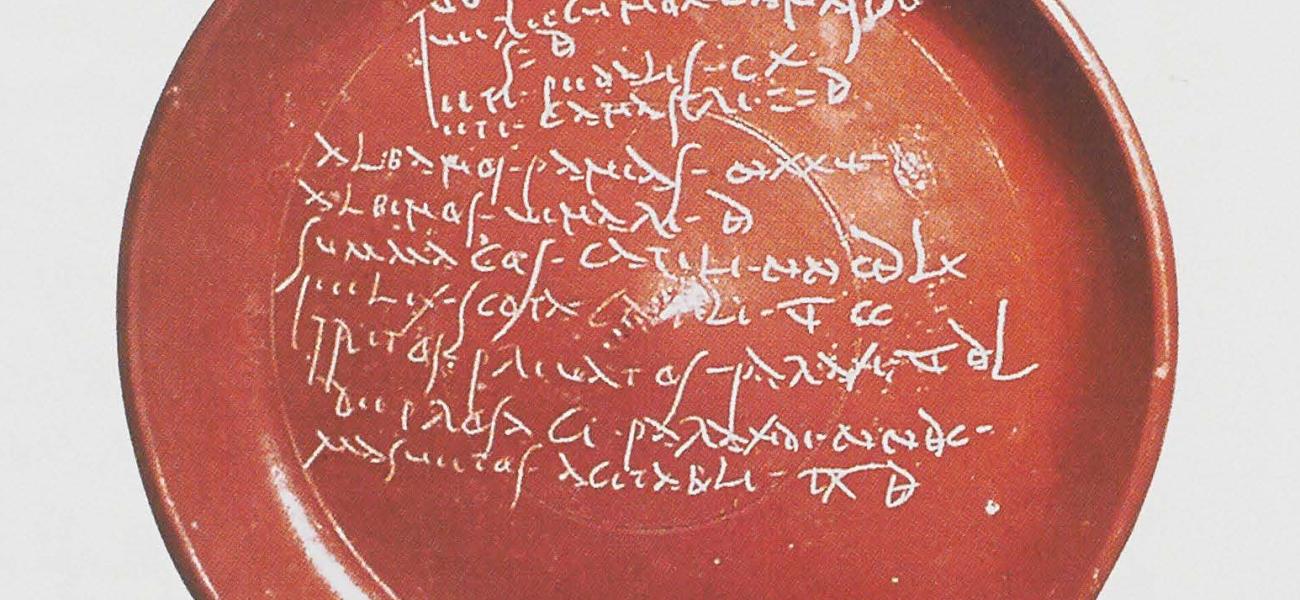Speaking Volumes: Pottery and Word
The relationships between ceramics and text, pottery and words, are very old and very new. These relationships may not be too obvious at first, but it is my intent to show here that there is a very intimate connection between clay and language, ceramics and the written text, and that this symbiosis between the two cultural phenomena is very ancient and profoundly meaningful. Much has been made of the use of words and text in art and in contemporary culture, especially in new media technologies, but that has been true of ceramic objects since the very beginning of recorded history.
The earliest examples of ceramic objects related to language and writing are clay tokens from Mesopotamia dating from 8000 B.C. (see Schmandt-Besserat, Before Writing). These tokens were part of an accounting system used in exchange and commercial transactions. Each little clay ball represented a unit of merchandise, i.e., a sheep, a measure of grain, etc. Beginning around 3700 BC, these tokens were enclosed in hollow clay spheres called bullas and kept in archives. Their use is rather interesting. When merchandise was moved, a bulla containing tokens representing the quantity of goods (say ten sheep) was given to the transporter. When the merchandise was delivered, the recipient would break the bulla to make sure that the correct number of sheep was delivered to him and none lost in transit. By 3500 BC, impressions were made on the outside of the bullas to represent the tokens, also called calculis, contained inside. For this reason, the bullas themselves became quickly obsolete, and similar impressions appear on clay tablets instead. By 3000 BC, these pictographs are simplified into cuneiform, angular signs made by pressing the wedge-shaped edge of a split reed into fresh clay. Thus a pictographic sign for "sheep" is progressively abstracted until it represents a code for "sheep", then the sound for the word "sheep," and then simply the phonetic and alphabetical aspects.. Through such a process* ceramic materials and technologies are involved in the beginnings of both mathematics and writing.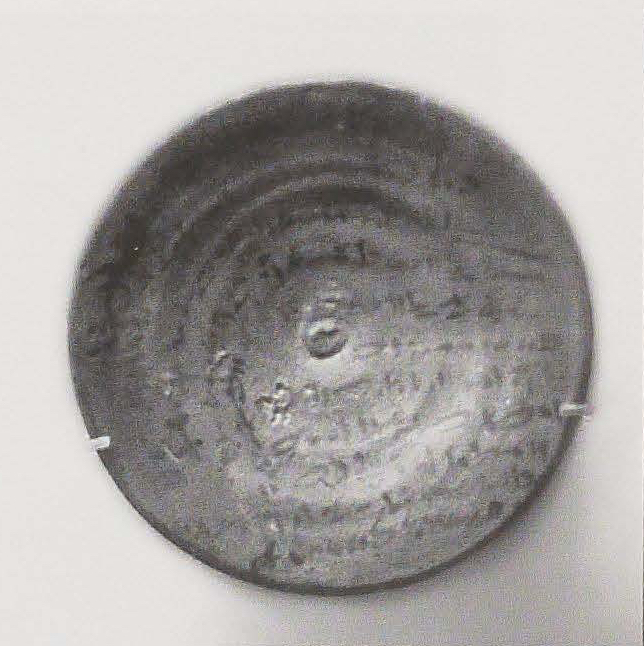
The overwhelming majority of cuneiform texts concerning business activities were written on clay tablets. Not all of these tablets were baked or fired, only those meant for permanent record, while unfired clay tablets were reused, remoistened, and altered. Most of those that have survived were originally unbaked; they were fired when the archive, the "library" where they were kept, burned down and the records were thus buried in the charred remains of the building until their discovery by archeologists. Clay was the ideal material for the preservation of these texts, some of which also hold the earliest examples of poetry and fiction. (It is believed that some texts were written on bark paper, which eventually was completely destroyed.) Early Mesopotamian cuneiform was thought to be the world's first written language, followed closely by similar developments in Egypt, but recent discoveries show that the Indus valley script, also found on clay tablets in the city of Harappa, emerged independently at the same time. Also, three clay tablets have recently been discovered at a site in Tartaria, Romania; they were produced by the Neolithic Vinca culture around 4000 BC, which may push the earliest date for written inscriptions back by a thousand years.
For the Mesopotamians, the idea of a permanent record was very important. In Mesopotamia, the achievements of rulers were inscribed on clay prisms or clay "nails," often inserted in the structure of buildings. This practice continues to this day in Iraq. Saddam Hussein had his name and accomplishments written on the bricks used for all public buildings constructed under his rale, as well as on all the reconstruction of historic buildings and sites. This is also true for all the preceding rulers of Iraq. Thus a record of the construction, repair, and reconstruction of major buildings .is embedded within the buildings themselves, sometimes over millennia.
This makes me think of all those bricks made by Robert Arneson with his name stamped on them; he will probably be thought to have been a very important ruler by future archeologists. This need to record, preserve, and maintain memory through the combined use of pottery and text can also be found on two sixth-century AD Anglo-Saxon cremation urns in the British Museum. One is marked with inscriptions in runes, recording the personal name of the deceased, while the other has similar markings which only imitate runes, since the maker of that urn was illiterate but felt the need to appropriate, even if erroneously, the power of the written word.
Writing is the most essential discovery of humankind after the still more ancient discovery of fire, and both are closely related to ceramics, both as an art form and in its contribution to the development of civilization and world culture. If the origin of writing and mathematics is closely related to clay, it is interesting to note that ceramic technology itself became mature at the same time as these developments, with the invention of the wheel, kilns, and the first glazes. This part of the world that we now call the Middle East not only gave us the earliest written texts, but also saw the birth of pottery and ceramics as a refined technology.
Most texts from Mesopotamia were of a commercial nature, statements of accounting and transactions, or they celebrated the military or civic accomplishments of rulers. But some of the most moving and informative ancient objects are those related to the daily lives of ordinary people with whom we can readily identify. Numerous incantation bowls have been discovered, painted on their interiors with drawings of devils and spirits, inscribed with spells meant to ward off evil, and positioned face-down to imprison and contain the evil. One also finds letters written on pots or shards, an example being a message from a mother to her dead son asking for his help and support from the afterlife. Many examples of these are in the British Museum or the Louvre.
Another small bowl from the Louvre, dating from Egypt in 592 BC, is written in "cursive demotic," the written form of ordinary people and everyday affairs, the hieroglyphic being reserved for official and religious documents. Papyrus being rare and expensive, ordinary people wrote on shards or discarded pots, thus preserving many of their texts. Clay and the firing process might also have served some magical purpose to guarantee the efficiency of the spell cast or the permanency of the contract signed. This little Egyptian bowl reads as follows:
Year four, second summer month, 20th : day under Pharaoh Psammetique, the lady Djetourisphaonkh, daughter of Nesmhat declares to Amenopouh: You have fulfilled my heart with money for which I become your servant. No other man in the world can reclaim me but you. I will not be able to consider myself a private independent person toward you, until I have reimbursed all money, all grain, any other thing in the world, including the children that will be born of me, with all that I own and everything I shall produce, with the clothes on my back, from this day of the year four, second summer month, from now and forever.
This very ordinary clay bowl, this simple domestic object, is also a record of enslavement for debt. Greek vases, too, are often inscribed with text, usually the names of the figures painted on the pots, but also unrelated elements like homage to young athletes to whom the vase might have been presented as a gift or prize.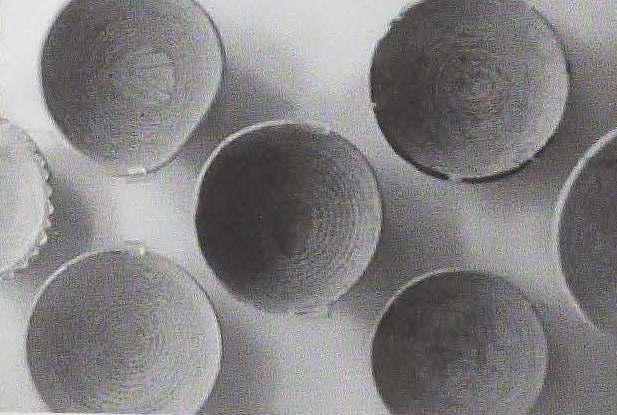
These inscriptions complimenting the youth on his beauty often help in dating the vase, since many of these celebrated boys became important civic figures later on and we can match their names with other dated records. These Greek vases are often signed by the potter who made them and/ór by the painter, at times the same person. We find vases inscribed "so-and-so made me" to refer to the potter, or "so-and-so painted me" to refer to the painter. A few vases are inscribed as having been made and painted by the same person or possibly under the supervision of a studio owner. Nineteenth-century connoisseurship has played a bizarre trick on us by attributing the painting on some vases to a fictional artist referred to as the "(potter's name) painter," the Amasis Painter being a famous example. Many pots are signed by the potter Amasis, and all of his production was painted by the same hand, which remains anonymous. Instead of attributing the painting on the vase to Amasis himself, a fictional character called "the Amasis Painter" was created! Amasis is thought to have been of Egyptian origin and possibly black. It was assumed that the painter had to be another person whose name has been lost, since the potter couldn't be the painter as well – despite numerous and celebrated examples to the contrary. The earliest signed Greek vase bears the mark of Sophilos, which makes him
the earliest recorded potter in history.
Another very interesting use of ceramic and text in Greek antiquity is the ostracon. When a citizen had been deemed unworthy due to an action or behavior, other citizens would pick a pottery shard from the ground, inscribe the name of the offending person on it, and deposit the piece in a special container reserved for that purpose on the public square. At public meetings, the shards were counted, and if a sufficient number of them held the name of an individual, that person was sent into exile. This practice gave us the word ostracize.
By the first century AD, we find small, unassuming dishes that are actually Gallo-Roman pottery accounts. These small plates are inscribed by scratching into the clay with a pointed tool, listing the contents of the kiln as it was being loaded. Potters worked in groups and shared firing facilities. Since the work produced was standardized and stylistically homogenous, a record was kept of the number and type of wares loaded in the communal kiln by each potter. This record on a clay plate or dish was then fired with the load. Before unloading, it was retrieved and each potter was given back the same number and type of objects, not necessarily those he had originally produced. Breakage was accounted for, and the loss was spread evenly and proportionately to what the original record showed. These inscribed accounting plates are very useful to archeologists and historians for determining the number and type of objects produced, the names of individual potters, and their number in any given community. They clearly demonstrate economic and social conditions as well as their evolution through time. Few actual pots survived, but these unassuming scratched dishes, which were instantly discarded to the trash pile, can be found at kiln sites all over Roman France.
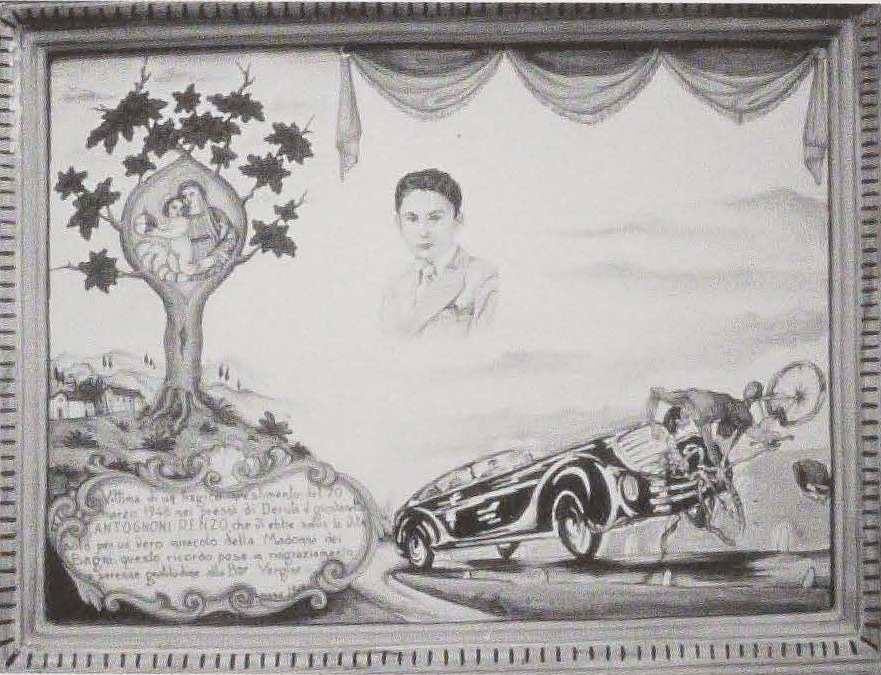
The Dead Sea Scrolls were written on parchment, but luckily stored inside pottery jars and sealed under lids, greatly helping in their preservation. Otherwise, bacteria or rodents, weather, or light itself would have long ago digested them.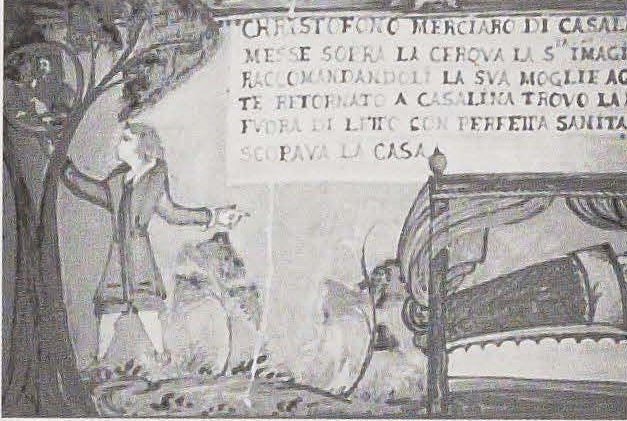
Through the Middle Ages and the Renaissance, one finds countless pots with inscriptions pertaining to daily life, marriages, births and deaths, celebrations and libations, as well as the names of the makers, painters, or patrons. Potters have always loved to inscribe their names on their wares, and this is often incorporated as part of the design. Italian Renaissance majolica abounds in inscriptions on vessels, mostly gallant messages to beautiful ladies or betrothal promises. Apothecary jars, found in large quantities in pharmacies and laboratories, bear the description of their contents. A number of other fascinating plates with sexual contents have been illustrated and discussed by Catherine Hess and myself in our book Sexpots: Eroticism in Ceramics. Another example of inscribed majolica can be found in Deruta, the place that saw the rebirth of that painterly technique at the beginning of the twentieth century. The small church of the Madonna del Bagno (Our Lady of the Bathtub) has interior walls covered with majolica ex-votos dating from the seventeenth century to the present. These commemorate events in the lives of the local people, most of whom work in the majolica industries of Deruta, and offer thanks to God and saints for favors obtained, from exorcisms to a crash between a car and a bicycle. These ex-votos, hundreds of them, offer us a record of the various stylistic and historical changes that have taken place in Deruta over the centuries.
In pre-Columbian America, pots with texts are common in the Mayan and Aztec cultures, the two literate New World cultures. Mayan pots with glyphs often describe the type of vessel, its contents, and the scene represented on the vessel. These glyphs are often found in a band, called the primary standard sequence, all around the rim; it is the pictorial element most commonly found on Mayan pots. The glyphs describe the name of the owner and sometimes the name of the scribe and/or the painter of the image, but never the potter who actually made it, although in the case of carved or inscribed vessels the writer and the maker may have been the same individual.
Such vessels were used in burials to contain food and drink for the afterlife, and remnants found in these containers confirm the relationship between inscriptions and contents. In Mayan script, the focus is entirely on rulers and their elite retainers: no mention of lower classes! We can only speculate on the status of potters, but it is evident that painters and scribes had a high status, since they are often represented on pots. In classic Mayan ceramics - at least the examples that have been preserved - there is not the slightest hint of economic or mercantile accounts, unlike the cuneiform of the Near East. Mayan written records emphasize mathematical calculations of dates and elaborate calendars of cycles and events in the very distant past, the present, and the very distant future. This complex relationship to time was central to Mayan cosmology and religion, as well as to the extremely hierarchical nature of society,:since knowledge, control, and prediction of the cycles were important for the maintenance of the priestly and military castes and for the establishment of dynastic legitimacy. The best ceramic examples are from the classic period, until 900 AD. From that time until the Conquest, there are few written documents left. It is believed that there was a shift from limestone or ceramics . to bark paper, a material more vulnerable to decay and destruction.
Presumably, many texts, perhaps even a majority, were once on perishable materials and objects, and thus lost to posterity. It begs the question, what will be left of our culture in the future? Many other historical objects pertain to drinking and libations. These can be found in most cultures, as far back as the Egyptians, Mesopotamians, Greeks, and Romans, as well as in Asia. These are inscribed with all sorts of wordplay, jokes, sayings, proverbs, and morals. A sixteenth-century Isnik tankard from Ottoman Turkey states: "The world is a banquet. If you pass through it and do not see this, you are a fool." Other inscriptions refer to political events, kings and queens, the Napoleonic wars, and military heroes; many great examples are to be found at the Victoria and Albert Museum in London. A very interesting example is the seal of the Emancipation Society made by Josiah Wedgwood, who was an early supporter and member of that organization at the end of the eighteenth century.
It was modeled for Wedgwood by William Hackwood and bears the message, "Am I not a man, and a brother" and the image of a Negro in chains in black basalt on white porcelain clay a very dramatic use of the contrasting clay bodies which brings together formally, in black and white, the conflict between the races. Another group of amazing domestic wares dealing with contemporary politics can be found in French faience made at the time of the revolution, between 1780 and 1800. Most of these wares with captions deal with revolutionary ideals and propaganda slogans, both for the monarchy and for the forces for change,
This tradition of revolutionary propaganda wares continues in Russia between 1915 and 1925. Imperial porcelain blanks, left unpainted in factories, were enameled by communist painters and avant-garde artists with aggressive bold pat terns (revolutionary in their own right), images, and propaganda statements meant to stimulate the people. The most touching examples deal with war and famine; at a time of great scarcity we find images of food and grain on plates, and texts such as "He who doesn't work, doesn't eat" or "The reign of the workers and peasants shall be without end," proof again that porcelain outlives revolutions.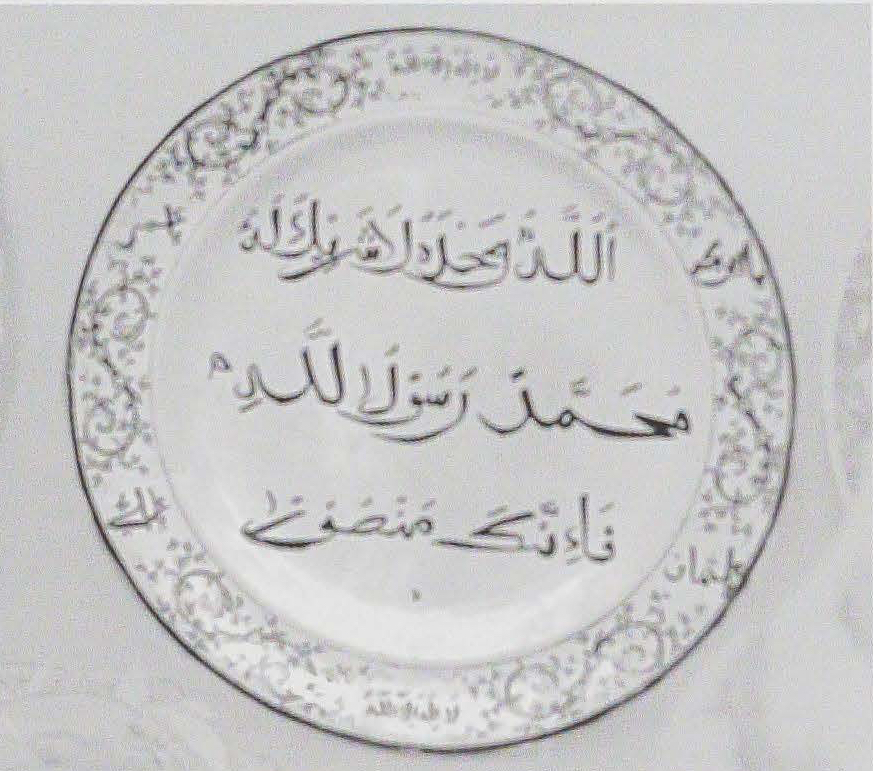
Political statements and commentary continue to this day in the work of numerous ceramic practitioners worldwide. In the Islamic world, script and text play a particularly important role, as does pattern. A bowl may be inscribed "the sacred month of Ramadan," the month of fasting during daylight hours, particularly appropriate in a bowl used for serving food. In wares with texts in a circular format, the text is often chosen for its formal quality as a graphic element that can be organized
in the round as much as for its intrinsic content. For the same reason, letters are altered, shortened, or lengthened to accentuate symmetry and graphic effect, sometimes to a degree that creates spelling errors on purpose. The oldest form of Islamic script, the geometric Kufic character from the city of Kufa on the Euphrates, is often found on buildings, since its geometric angularity translates well onto bricks and tiles, but it is difficult to read due to its abstraction and extraneous ornament.
It was eventually superceded by a cursive script, which was also extensively used on buildings despite its extraordinary formal complexity. The text on 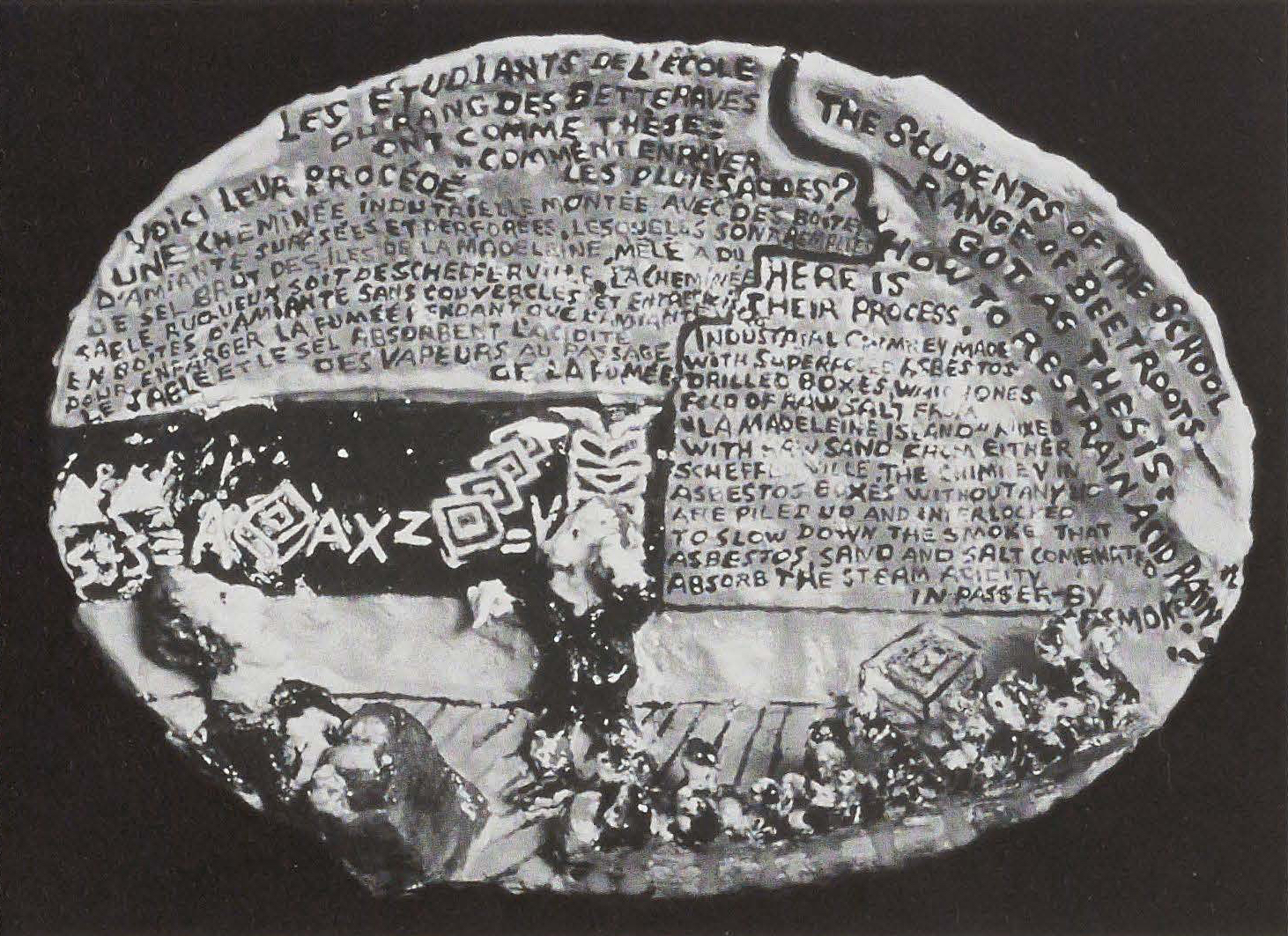
Transfer prints in Arabic appear on an English plate made by Copeland about 1853. These plates were made to be exported to Indonesia, where they were very popular, according to Oliver Watson, curator of ceramics at the V &A The script is "a rather curious one... copied from Arabic scripts that appear in China rather than anything Middle Eastern or European. The inscription is Koranic and refers to Muhammad and Allah." I find fascinating such an English plate with Arabic text, made for the Indonesian market, with an inscription copied from a Chinese transcription of a Middle Eastern original! Layering, appropriation, cultural (mis)quotations and globalization are not entirely postmodern after all.
Different, sometimes surprising, inscriptions' occur on different kinds of objects. An 1801 redware pie plate from New York has a slip-trailed decoration that asks, 'Why will you die?" George Ohr often added inscriptions on his work. When his friend, the potter Jules Gabry, died, Ohr was very shaken and recorded the sad event several times on different pots, including one that reads: "Jules Gabry, born in France, r829, suicide in Biloxi's water, August r8,1897,68 years, poverty cause."
Another inscription by an American potter is on a large jar by "Dave," a literate slave at Lewis Miles Pottery in South Carolina. A number of his massive storage jars carry his incised poems, such as "A noble jar for pork and beef, then carry it around to the Indian chief." Dave was an accomplished potter, who threw the largest pots known to have been made from Edgefield district. The biggest of his "noble jars" held over forty gallons.
China and Asia are also very fertile ground for the use of calligraphy on pottery. Many porcelain wine ewers were made in the shape of characters for happiness or longevity, two very appropriate symbols on objects used for drinking and made with such a timeless material. A contemporary example would be the Ampersand teapots of Adrian Saxe which reinterpret the Chinese originals. Porcelain seals are also very common, the forerunners of printing blocks and movable type. Movable type for printing longer texts was actually invented in China by Pi-Sheng in r 041, centuries before Gutenberg in Germany. As you might have guessed, these earliest movable types were made of fired clay.
In Japan, the potter Ogata Kenzan, 1663- 1743, often used poetry to decorate his wares, both in his individual work and in collaboration with his celebrated painter brother, Korin. These poems make references to the times of the year when a particular utensil was actually used, or they were playful accessories for games, for guessing what poem was hidden under the food, helped by clues offered by the visible painted image. In the 1950s, Kitaoji Rosanjin and Tomimoto Kenkichi both used script on their functional yet highly decorative wares. An example of a Tomimoto plate shows four characters for wind, flower, snow, and moon, all referring to change and impermanency.
Their contemporary Sawada Chitojin does the same on his vases covered with inscriptions in old Japanese, mostly decorative since it is now reduced to abstract signs and cannot be read by anyone but experts.
CONTEMPORARY USES OF TEXT ON CLAY
In America, ceramist Steve Freedman, now living in Hawaii, is probably the ceramic artist who has used narrative text in the most consistent, sustained, and efficient manner. He often cuts letters and texts from the walls of large thrown or cast vessels, rendering them nonfunctional, unable to hold anything but meaning in the void left by the missing letters and the opened, pierced interior space. "All the important possessions of my race and my ancestors can be contained within these two vessels" reads one pair. Another states: "Pretend that these spaces can be filled with this translucent viscous substance, thus closing the doorway to places YOU CAN NO LONGER GO, THINGS YOU CAN NO LONGER FEEL, but may wish to view from time to time." The vessels at times carry poems by surrealist artist Kenneth Patchen time to time." The vessels at times carry poems by surrealist artist Kenneth Patchen or by Vietnam War veteran Grady Harp, who collaborated with Freedman on a series of vessels for their installation War Songs. Others have text that is so abstracted, fragmented, or altogether jumbled that it simply reads as a decorative motif, impossible to decipher. This interest in language, poetry, and history — as well as the preservation of memory and the containment of space, time, and meaning - connect Freedmart’s work to the clay tablets of the Mesopotamians. Wu Min is a contemporary Yixing potter from China who also uses poetry to add meaning and content to his technically superb yet traditional teapots. In his 1996 series entitled The Modest Gentleman, he has transformed the domestic object into a form resembling a bamboo tank, changing the menacing war machine into an unthreatening, fragile toy and a functional utensil. The title itself, The Modest Gentleman, makes me think of the Chinese student stopping tanks in their tracks on Tienanmen Square.
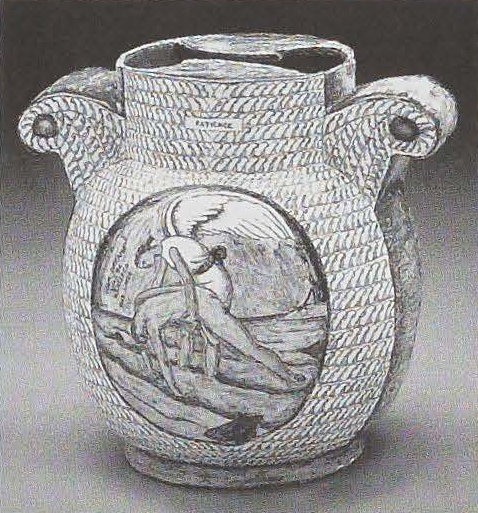
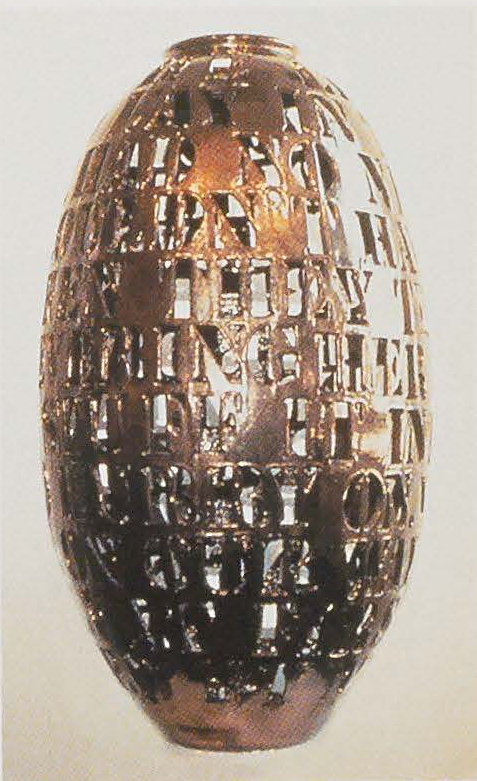
The work of New Yorker Ann Agee embodies perfectly all the ideas I discuss here. In her work of 1991, realized during a residency at the Kohler factory in Wisconsin, she recorded portraits of employees along with information about their lives, interests,and work at the factory. From these plates and large tile panels, much can be learned about the working conditions of these people and the times they live in. These objects will eventually serve as a historical record for future archeologists, and as such will provide valuable information. The potential for ceramics to record, contain, preserve and transmit time is not yet irrelevant. Along with the millions of toilets and sinks made at Kohler, these objects of Ann Agee's will act as our testament.
Canadian artist Baco Ohama uses text obsessively in room-size installations dealing with her identity as a Japanese-Canadian, as well as other issues regarding gender, culture, and difference. She rolls long coils of clay by hand and laboriously "writes" words with them. After firing, these fragile and vulnerable pieces are carefully pinned to the wall to reconstruct the original text. Different colors of clay are used - brown, white, or black for skin tone; red for Japan - to reinforce meaning.
Confronted with these ambitious and overpowering pieces, we are made aware of the intensity of labor, the amount of time invested, and the vastness of feeling they represent. This intense identification holds the spectator in place, and this pause provides the time for reading and communication to take place. Then the work is disassembled and probably now difficult if not impossible to reconstruct, like so much impermanent contemporary art. This symbiosis of permanency and fleetingness, of solidity and temporality, and this layering of conceptual intent with intense personal content, are also emblematic of the times we live in.
Anne Kraus's work of the past twenty years pushes the limits of the narrative scene and loads it with psychological tensions. The captions written on her vessels are descriptive, yet deliberately incomplete and confusing: "ROAD'S END, TURN BACK, One Cold Autumn Morning I Wished You Luck and Watched You Go. What Do You Hope To Find Out There." These sentimental vignettes play a mostly formal role, to animate the space and decorate the object, as do the other patterns and colors. The usual hierarchy between text, image, pattern, color, and object itself becomes flattened and irrelevant
in an over-determined jumble of seductive materiality and skill.
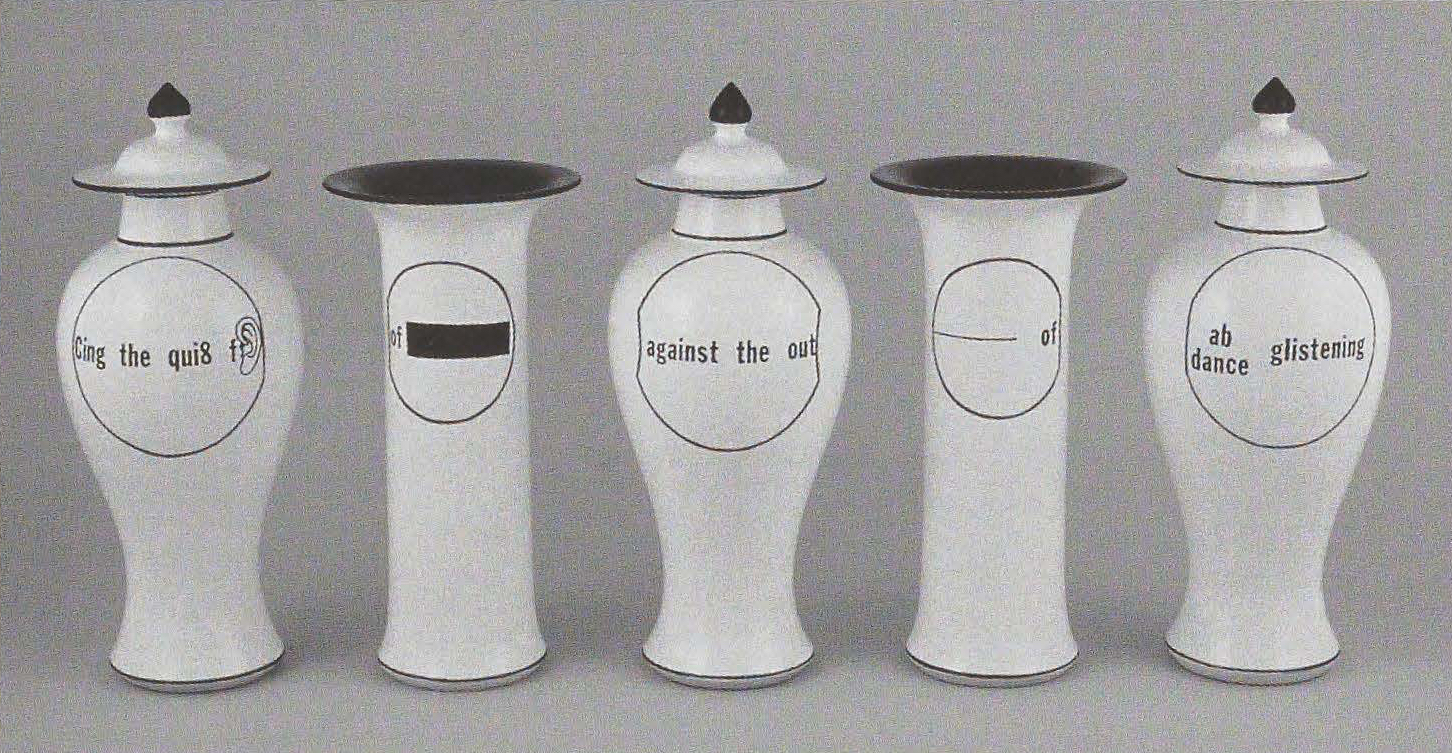
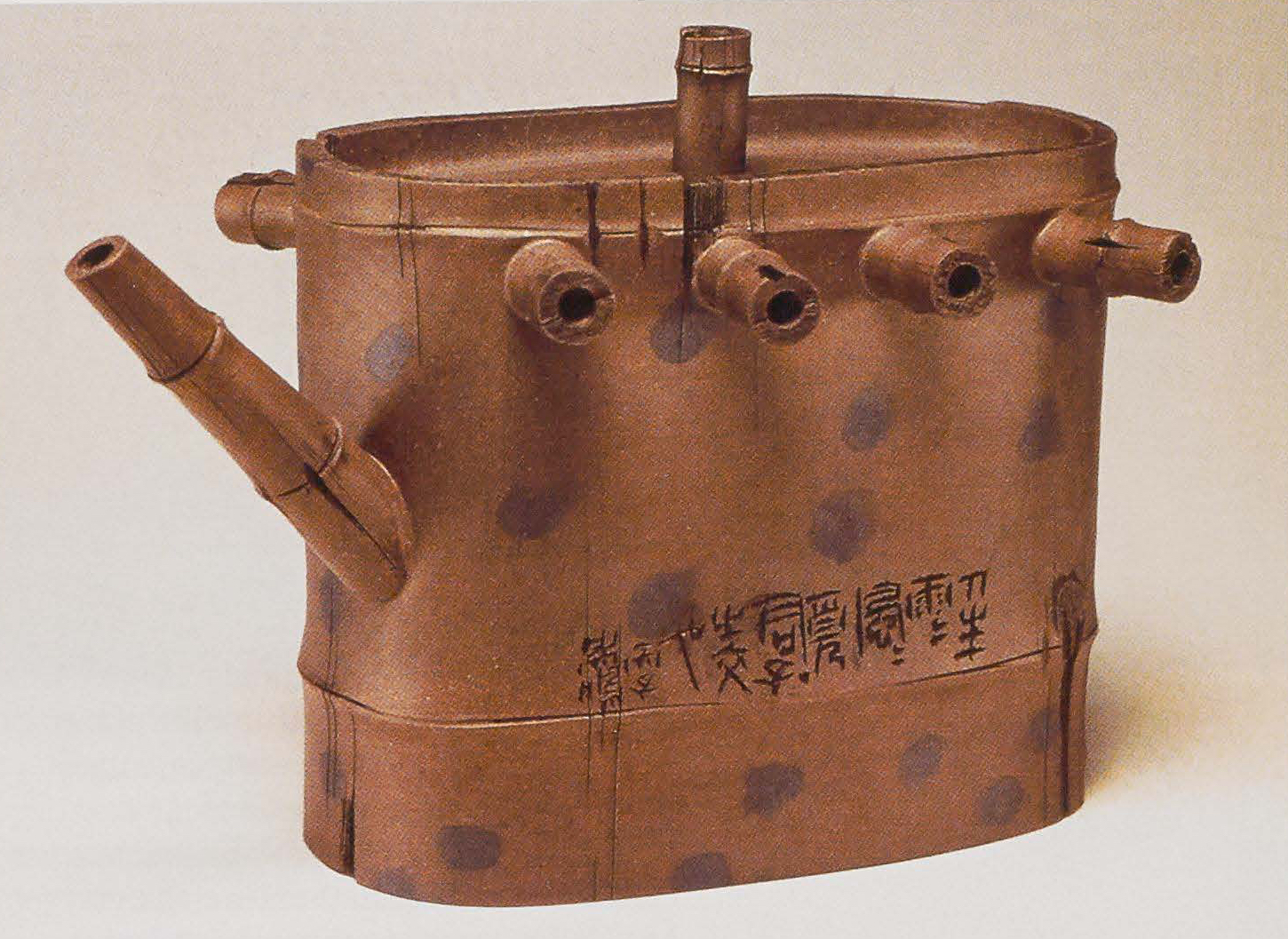
Edouard Jasmin started his ceramic work after retirement and worked until his death. Near the end of his life, his work became popular in Toronto and then New York, and he felt the need to translate everything in order to accommodate his expanding market. At times, this accommodation is pushed to extremes; the French and English texts end up taking up most of the available space, leaving hardly any space for the vignette, which should be the central focus. Yet the final effect is all the more funny, efficient, and brilliant for that reason.
Books are containers of language, and like pots they transmit and transport knowledge and history; they preserve and transmit time and memory. The first books were written on clay, and they came to us through millennia for that reason. Takako Araki from Japan, who died in 2004, worked with the Bible form for many years. Maybe someday all that will be left of the Judeo-Christian tradition will be the scorched and incomplete fragments of the Bible to be found in Araki's work. Robert Arneson likewise made his Book of Secret Glaze Recipes permanently closed and impossible to consult. Another name for book is volume. Volume is also the defining factor in pottery; it is what makes containment possible. Here again, at the semantic level, there is a close connection between clay and language. The open ceramic books of Takako Araki embody permanency and decay simultaneously, and they remind us of the transience of authoritative statements, dogmas, codes and beliefs.
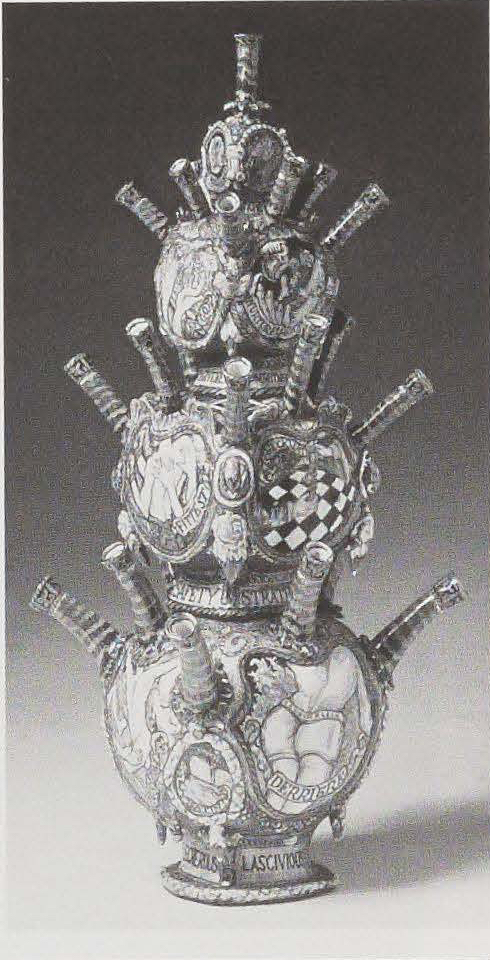
Nevertheless, if I wanted to pass along some knowledge, some record, some trace to the future, I would do like the Mesopotamians, and fire it on clay.
Ceramics is the memory of humankind.
